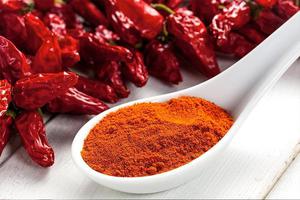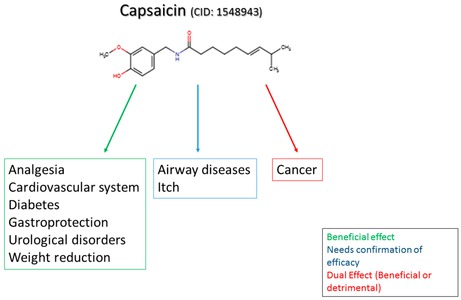A reliable source on many subjects.

A reliable source on many subjects.

![]()
 Do you love the spicy flavor of hot peppers?
Do you love the spicy flavor of hot peppers?
Then you’re in luck, because capsaicin can help you prevent cancer, fight diabetes, relieve pain and even lose weight.
So let’s find out right away how this natural element works and what medicinal properties it contains.
 Capsaicin is a molecular compound found in spicy chillies. It is found in all parts of the bell pepper except the seed. Its highest concentration is in the inner wall where the seeds are attached.
Capsaicin is a molecular compound found in spicy chillies. It is found in all parts of the bell pepper except the seed. Its highest concentration is in the inner wall where the seeds are attached.
It has been called a natural and proven aid to weight loss, cancer treatment and even chronic pain relief.
It works by binding to a vanilloid receptor known as TRPV1. The latter is responsible for signalling any sensation of heat, as occurs when the body’s cells are physically burned or injured.
Once the capsaicin molecule is bound to the TRPV1 receptor, the brain receives a signal that a burning or heating event has occurred. As a result, it reacts by inducing a mild inflammatory response designed to repair the affected cells.
It is through this reaction that many of capsaicin’s benefits are realized.
Peppers have been around for a long time, but the “spicy” component of capsaicin was not isolated until 1846, when a man named JC Thresh identified it and gave it that name.
Before that date, in 1819 to be exact, Christian Friedrich Bucholz extracted an impure form of the compound. He gave it the name “capsicim”, which is the old name for capsaicin, in reference to the Capsicum from which it was taken.
A century after its discovery, its chemical structure was recorded in 1919 by E.K. Nelson and was created synthetically in 1930 by E. Spath and F.S. Chéri.
An interesting feature of capsaicin seems to be that this nutrient arose from an evolutionary need for protection in peppers.
Indeed, capsaicin is a deterrent for certain animals and mammals that destroy the plant’s seeds, with the exception of birds, which are immune to it. Proof that nature is well done, since birds swallow the seeds whole, helping to perpetuate the plant’s growth. [1].
The presence of capsaicin in spicy chillies is determined by their level of “heat”, which is measured according to the Scoville Heat Scale (SHU) that identifies different chillies.
For example, capsicum ranks between 0 and 100 on the Scoville scale, cayenne pepper between 30,000 and 50,000, piperine between 100,000 and 160,000, and habanero bell pepper between 100,000 and 350,000. [2].
Capsaicin has numerous health benefits.
Here are just a few:
The anti-cancer activity of capsaicin has been scientifically demonstrated.
In fact, capsaicin can combat numerous cancers, including breast and prostate cancer.
A study carried out in Japan attempted to assess the possible chemopreventive effects of spice-derived compounds on gastritis induced by Helicobacter pylori (H. pylori).
The results obtained suggest that capsaicin and piperine have anti-inflammatory effects on H. pylori-induced gastritis in gerbils independently of direct antibacterial effects, and may therefore have potential for use in the chemoprevention of H. pylori-associated gastric carcinogenesis. [3].
Another study carried out at the College of Pharmacy, Seoul National Universityin Seoul, South Korea, showed that capsaicin caused a dose-dependent disruption of growth in breast cancer stem cells and inhibited translocation of the notch intracellular membrane domain (NICD) into the nucleus. [4].
Research has revealed that eating spicy foods can reduce body weight, speed up metabolism, help burn fat and suppress appetite in animals.
In fact, a study carried out by a group of researchers from the Research Institute of Atherosclerotic Disease, Xi’an Jiaotong University School of Medicineshowed that capsaicin intake can prevent diet-induced obesity [5].
Consumption of capsaicin also improves athletic performance and overall physical endurance.
One study attempted to investigate the analgesic effects of capsaicin and its clinical applicability in the treatment of pain.
In particular, researchers reviewed its other clinical therapeutic uses and implications in diseases such as obesity, diabetes, cardiovascular disease, cancer, airway disease, itching, gastric and urological disorders [6].
In the figure below, researchers have summarized current knowledge of disease-related capsaicin activities.
The green arrow indicates diseases in which capsaicin has beneficial effects, and could therefore be useful as a treatment.
The blue indicates diseases in which the effect of capsaicin is still controversial, and the therapeutic effect of capsaicin and TRPV1 agonists and antagonists needs further study.
And red indicates that capsaicin may play a role in cancer prevention.

A study investigated the effect of capsaicin supplementation on blood glucose, lipid metabolism and pregnancy outcomes in women with gestational diabetes mellitus (GDM).
The researchers concluded that capsaicin-containing chili supplementation consistently improves postprandial hyperglycemia and hyperinsulinemia as well as fasting lipid metabolic disorders in women with GDM, and decreases the incidence of gestational-age neonates [7].
On the other hand, in patients with painful diabetic peripheral neuropathy, treatment with repeated 8% capsaicin patches reduced this condition [8].
Researchers at the Department of Dermatolog, University of Michigan Medical Schoolevaluated the safety and efficacy of topical capsaicin in patients with pruritic psoriasis.
They concluded that topically applied capsaicin effectively treats pruritic psoriasis, a finding that supports the role of substance P – an undecapeptide neurotransmitter involved in the pathophysiology of psoriasis and pruritus – in this disorder [9].
The easiest way to introduce capsaicin into your diet is to eat foods that contain it, i.e. all varieties of bell pepper.
If you’re not used to eating spicy foods, it’s important to go gradually and start with mild varieties that aren’t too spicy.
You can also buy capsaicin in supplement or cream form.
The latter form is ideal for the treatment of psoriasis, as well as benefits such as easing pain or treating cluster headaches and relieving joint and muscle pain.
There are many capsaicin supplements on the market.
Here are two examples of effective products:
This natural weight loss supplement increases energy, helps moderate appetite, supports metabolism, induces a heat effect and induces lipolysis.
Capsiplex was created using OmniBeada technology that delivers the thermogenic power of hot red peppers without the burning effect.
Capsiplex is highly concentrated and effective, and does not irritate the oral or gastric tract. The 1-month treatment costs €39.99.
Capsimax by Abs is a supplement extracted from chili pepper (capsicum) that acts as a powerful fat-burning, energy-boosting thermogenic.
It increases energy expenditure and promotes weight loss in both men and women.
Abs Capsimax stimulates the “digestion” of carbohydrates (sugars) in runners at rest and during exercise. It also increases fat oxidation and lipid burning necessary for weight loss, and reduces calorie intake.
This product received the 2009 Scientific Excellence Award from SupplySide West in the United States. The 1-month treatment costs €29.
Due to its pain-inducing effect, capsaicin should be consumed with caution.
Generally, the amount present in common foods is safe to consume, but it can sometimes lead to heartburn or stomach pain, nausea, diarrhea and other digestive problems.
In supplement form, it is recommended not to exceed 3g per day.
Some people may experience acid reflux when taking capsaicin orally.
If you are one of these people and regularly experience indigestion after eating spicy foods, you should avoid taking capsaicin.
In rare cases, capsaicin can cause allergic reactions in some people.
Capsaicin works as an alkaloid. If you experience symptoms such as joint pain, skin redness, digestive problems or a noticeable inflammatory reaction, you may be allergic to this class of food.